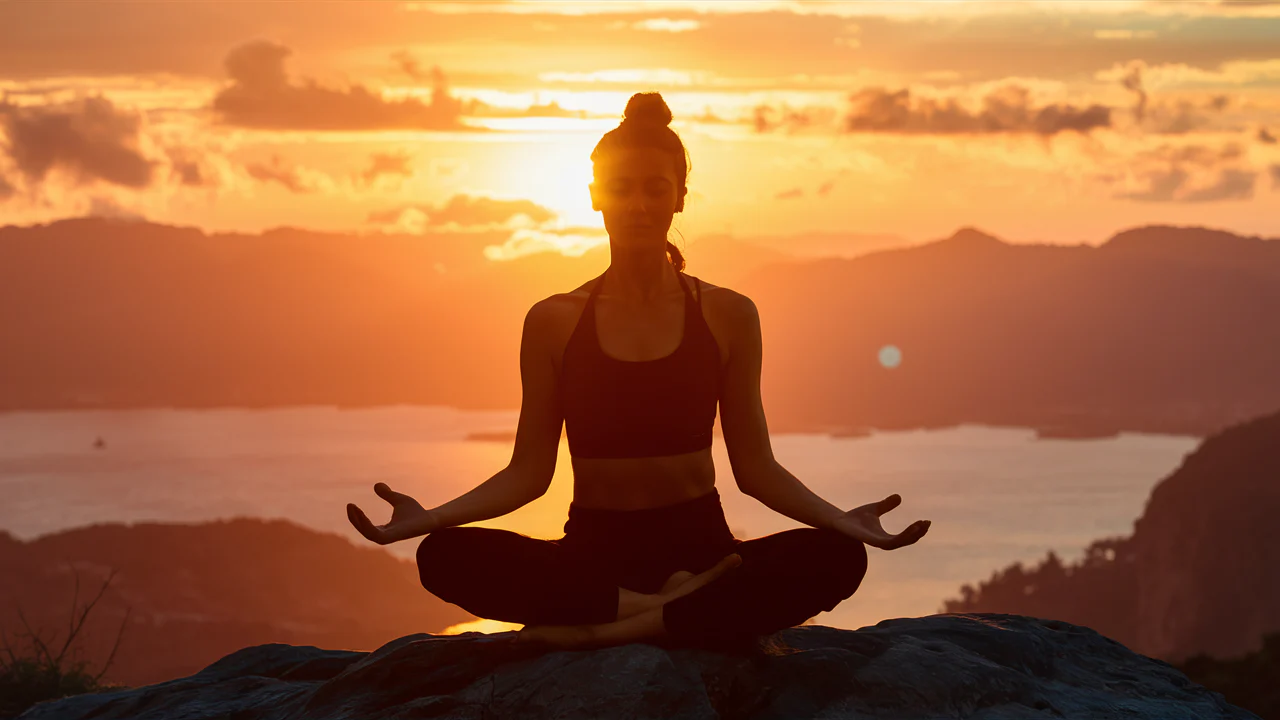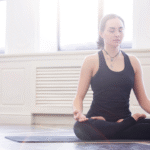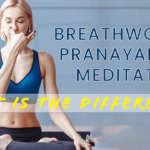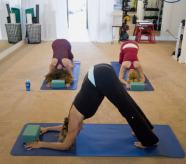Understanding Diverse Yoga Styles
Different yoga styles cater to various preferences and goals, from dynamic flows to gentle, meditative practices. Understanding their unique characteristics can help you find a style that resonates with your needs and complements your lifestyle.
Hatha Yoga
Hatha yoga is often considered the foundational style from which many other forms originated. It emphasizes holding poses for several breaths, with a strong focus on alignment and foundational postures (Source: Yoga Journal). Classes typically move at a slower, more deliberate pace, making it an excellent choice for beginners looking to learn basic poses, build strength, and improve flexibility (Source: Verywell Fit). The primary focus is on mindful movement and breath control (pranayama), fostering a deep connection between body and mind. If you’re wondering which yoga class is best for beginners, Hatha is frequently recommended as an accessible starting point.
Vinyasa Yoga
Vinyasa, meaning “to place in a special way” and often referring to the synchronization of movement and breath, is characterized by its dynamic, flowing sequences (Source: Yoga Journal). Poses are linked together smoothly, often set to music, creating a continuous and almost dance-like movement experience. Each class can vary significantly as instructors have the freedom to choreograph unique sequences, offering immense creativity and variety. Vinyasa builds heat, endurance, and flexibility, appealing to those who enjoy a more vigorous, rhythmic, and physically engaging practice.
Ashtanga Yoga
Ashtanga yoga is a highly structured and physically demanding style developed by K. Pattabhi Jois (Source: Ekhart Yoga). It follows a precise sequence of poses, always performed in the same order, starting with the primary series and progressing through intermediate and advanced series. The practice emphasizes synchronized breath (Ujjayi), specific gazing points (drishti), and internal energy locks (bandhas), known as the “Tristhana.” Ashtanga is renowned for building immense strength, stamina, and discipline, making it suitable for dedicated practitioners seeking a challenging and consistent routine.
Yin Yoga
Yin yoga is a slow-paced, meditative style where poses are held for extended periods, typically three to five minutes, or even longer (Source: Yoga Journal). The focus is on targeting the body’s connective tissues—ligaments, joints, bones, and fascia—rather than the muscles. Poses are often floor-based and involve minimal muscular effort, allowing gravity to gently deepen the stretch. Yin yoga is excellent for improving flexibility, cultivating patience, and calming the nervous system, offering a deep, introspective complement to more active styles. For those looking to understand how long to hold a yoga pose, Yin provides extreme examples of sustained holds.
Restorative Yoga
Restorative yoga aims to deeply relax the body and mind by extensively using props like bolsters, blankets, and blocks to fully support the body in gentle poses (Source: Verywell Fit). Poses are held for extended durations with complete support, allowing for passive stretching and profound relaxation. This style is specifically designed to soothe the nervous system, reduce stress, and promote healing and recovery, making it ideal for stress relief, injury rehabilitation, or simply those seeking a very gentle and calming practice. It can be particularly beneficial for promoting the mental health benefits of yoga.
Bikram Yoga (Hot Yoga)
Bikram yoga consists of a standardized sequence of 26 postures and two breathing exercises, performed in a specially heated room (typically 105°F with 40% humidity) (Source: Yoga International). The intense heat is believed to aid in detoxification, increase flexibility, and prevent injuries by warming the muscles. Each posture is performed twice. While physically demanding due to the heat and intensity, the consistent sequence allows practitioners to easily track their progress over time. It’s a structured practice that appeals to those who thrive in challenging and predictable environments.
Iyengar Yoga
Named after its founder, B.K.S. Iyengar, this style places meticulous emphasis on precise anatomical alignment and the intelligent use of props (straps, blocks, chairs, walls) to achieve correct form (Source: Yoga Journal). Poses are held for significant periods, allowing practitioners to thoroughly explore and refine their alignment and understand the subtle actions within each posture. Iyengar yoga is renowned for its therapeutic benefits and is often recommended for individuals with injuries or those who want to deepen their understanding of anatomical precision and body mechanics.
Yoga Nidra: The Practice of Yogic Sleep
Yoga Nidra, often referred to as “yogic sleep,” is a powerful state of conscious deep relaxation that systematically guides the practitioner through various levels of brainwave activity. It moves from active beta waves to alpha (relaxed wakefulness), theta (light sleep/deep relaxation), and even delta (deep sleep without losing awareness) states (Source: Psychology Today). This practice is particularly effective in addressing both stress and anxiety due to its profound impact on the nervous system and mind.
For stress reduction, Yoga Nidra intentionally activates the parasympathetic nervous system, also known as the “rest and digest” system. In contrast, chronic stress often keeps the sympathetic “fight or flight” system engaged. By shifting the body into a state of deep relaxation, Yoga Nidra helps lower heart rate, reduce blood pressure, and decrease the production of stress hormones like cortisol (Source: Cureus Journal of Medical Science). Studies have shown significant reductions in stress levels among participants regularly practicing Yoga Nidra (Source: Frontiers in Psychology). The structured rotation of awareness through different body parts and sensations also helps to release muscular and mental tension, which often accumulates under stress.
When it comes to anxiety, Yoga Nidra offers a unique approach by fostering a sense of inner calm and detachment from anxious thoughts. By moving into deeper brainwave states, the mind quiets, allowing for a much-needed break from the ruminative thinking patterns that fuel anxiety. The practice often includes an intention (sankalpa) and guided visualizations that can help reframe negative thought patterns and cultivate positive mental states (Source: Cureus Journal of Medical Science). Research indicates that Yoga Nidra can significantly reduce symptoms of anxiety, improving emotional regulation and promoting a greater sense of peace (Source: Cureus Journal of Medical Science). For those seeking to manage anxiety through yogic practices, exploring yoga for anxiety or understanding the mental health benefits of yoga can provide additional profound support.
Holistic Benefits of Regular Yoga Practice
Regular yoga practice offers a holistic approach to well-being, encompassing a wide spectrum of physical, mental, and even spiritual advantages. Consistently engaging in yoga can transform your overall health, leading to a more balanced and vibrant life.
From a physical standpoint, yoga is renowned for significantly improving flexibility, strength, and balance. Poses work to lengthen muscles, build core stability, and enhance coordination, which can also contribute to better posture. For those experiencing discomfort, yoga can be a powerful tool for alleviating chronic pain, including common issues like neck pain or lower back discomfort (Source: Johns Hopkins Medicine). Furthermore, studies suggest that regular practice may enhance respiratory and cardiovascular function, support bone health, and even improve sleep quality (Source: Mayo Clinic).
Beyond the physical, yoga cultivates profound mental and emotional benefits. It is widely recognized for its ability to reduce stress and anxiety by calming the nervous system and lowering the production of stress hormones like cortisol (Source: Cleveland Clinic). Regular practice fosters mental clarity and calmness, sharpens concentration, and improves overall mood, helping to mitigate symptoms of depression and fatigue (Source: American Osteopathic Association). The emphasis on breathwork and mindfulness also strengthens the mind-body connection and can enhance memory and focus.
For many, yoga is also a path to spiritual growth and inner harmony. It encourages a deeper sense of self-awareness and inner peace, fostering a connection to one’s authentic self (Source: Chopra.com). This practice can instill virtues such as compassion, gratitude, and contentment, promoting a sense of unity and interconnectedness with the world around you (Source: Yoga Alliance). Ultimately, yoga serves as a powerful tool for achieving a holistic state of well-being, integrating the physical, mental, and spiritual aspects of life.
Sources
- American Osteopathic Association – Benefits of Yoga
- Chopra.com – The Spiritual Benefits of Yoga
- Cleveland Clinic – Benefits of Yoga
- Cureus Journal of Medical Science – Yoga Nidra for Stress Management: A Review
- Ekhart Yoga – What is Ashtanga Yoga?
- Frontiers in Psychology – Stress Reduction through Yoga Nidra: A Systematic Review
- Health Harvard – Yoga for Pain Relief
- Johns Hopkins Medicine – 9 Benefits of Yoga
- Mayo Clinic – Yoga: Benefits Beyond the Mat
- NCBI – Effects of Yoga on Respiratory and Cardiovascular Function
- Psychology Today – What is Yoga Nidra and How Does It Work?
- Verywell Fit – Hatha Yoga Poses for Beginners
- Verywell Fit – Restorative Yoga: A Beginner’s Guide
- Yoga Alliance – Benefits of Yoga
- Yoga International – Bikram Yoga: What You Need to Know
- Yoga Journal – Hatha Yoga Explained
- Yoga Journal – Iyengar Yoga Explained
- Yoga Journal – Vinyasa Yoga Explained
- Yoga Journal – Yin Yoga Explained
Conclusion:
Different yoga styles serve unique goals, from dynamic flows to deeply restorative practices. Hatha Yoga builds strong foundations with alignment and mindful breath, ideal for beginners. Vinyasa and Ashtanga emphasize flowing or structured sequences, boosting stamina, strength, and discipline. Yin, Restorative, and Yoga Nidra focus on relaxation, stress relief, and deep nervous system healing. Meanwhile, Bikram and Iyengar highlight precision, heat, and props, offering structure and therapeutic benefits—together showcasing yoga’s diverse paths to wellness.











